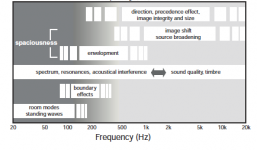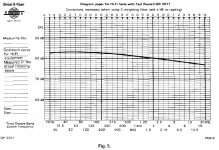This is definitely a real issue in professional (large room) applications, but in a "home" environment (with 0dB fs set to give 105dB at the listening position) there is no lack of "dynamics" with most decent direct radiators . . . my ORION delivered, quite linearly, essentially 100% of the "dynamic range" on the recording.It still lacks the dynamics and power handling of a compression driver
For people who "like it louder" sure, horns are the way to go (and lots of the other issues of "accuracy" don't matter either).
Anyone who has experienced a high directivity speaker in 100-1kHz range in a small room ....
Corner horn?
It's all about marketing semantics. There is no such data you are asking for...
The fact that gedlee is not doing it is he cannot sell it.
I'm not ready to jump to this conclusion, which is why I asked Earl the question.
Let's consider reproduction of correct ITD cues in a small room. ITD range is below 1kHz. Only possible with high directivity speakers.
Corner horn?
I never understood this concept. Wouldn't any corner placement act as a corner horn? Also, what directivity? Its like being inside a horn...frequencies will be omni.
Let's consider reproduction of correct ITD cues in a small room. ITD range is below 1kHz. Only possible with high directivity speakers.
... also possible with near field concept like Linkwitz Watson..
By using the old B&K falling response. It's been posted a few times and is easy to find around the web. I use it, I think Geddes uses something close. It does seem to work well in most domestic rooms.
I'm not sure why it sounds right, unless the mastering engineers are using it, too.
If there's no theoretical justification then the B&K curve exists because someone, somewhere, decided it "sounds" right. And you agree. But there we go again . . . with "objective" measurements referenced to a "subjective" standard. …
http://www.bksv.com/doc/17-197.pdf
Quote from page 4 :
When music is recorded under far-field conditions, it will contain a suitable mixture of direct and reflected sound, and the curve ought to be absolutely flat in that case. This is true for recordings, for instance, made with two B &K condenser microphones in the far-field.
However, since most recordings are made as a combination of near-field and far-field information, the curve should boost a little at low frequencies and roll off a little at high frequencies. A suitably shaped curve is shown in Fig.5.
The curve shows only the necessary tendencies. This curve was derived partly as a result of listening tests and partly by consideration of curves from average concert halls.
According to Beranek (Ref. 2) the average concert hall has a roll off similar to that in the curve shown, but at twice the rate. Only half the rate is chosen because most recordings are equally distributed between near-field and far-field recording.
Practice has shown that this characteristic is absolutely reasonable for reproduction of most commercial recordings.
George
Attachments
The fact that we are not sensitive to sound reflections below about 500 Hz..
..means that there is little need for controlled directivity below that frequency.
Where is the extensive thorough testing to show that we are sensitive to reflections above 500 Hz in the context of loudspeaker and small room? (..Reflections considerably greater than any bounding condition, necessarily delayed in time and intensity from direct sound as is common in the context of a listening room.)
Even if there was such a "fact", and a great deal of Toole's work suggests otherwise, how does that mean that controlled directivity below 500 Hz results in "little" need in any given design?
IF we could say conclusively that reflections weren't an issue below 500 Hz, does this necessarily preclude an audible advantage to maintain controlled directivity?
Again, where is that high quality objective data that you can only rely on? Last time I checked, an educated guess doesn't really meet that requirement.
To have a constant power response down to the schroeder frequency makes complete sense and is clearly the ideal.
Ditto, thanks George! I remember reading something like that, but not the details. Thanks for the link.
I never understood this concept. Wouldn't any corner placement act as a corner horn? Also, what directivity? Its like being inside a horn...frequencies will be omni.
Using the North American scale for a small room in the ~15 foot minumum range, it seems the only obvious way to control the wavefront in any meaningful sense down to waveflengths approaching room dimensions.
I have to agree with all of this since all of my mixing rooms have this curve thanks to Bob Hodas advice, and his calibration skill. My own personal hometheaters and multichannel music rooms also have this same curve.
Yes, and if one spends a bit of time on Audiolense, Acourate, or DRC forums, this curve is consistent with many folks experiences regardless of type of speaker or room.
For example, Bob Katz uses Lipinski L-707 and stereo JL Audio Fathom f112 subs, which are clearly different from my horns. Yet we both measure the same frequency response at the listening position, (i.e. the curve I posted earlier in the thread), even though the size and acoustic treatment of our rooms are different.
How do I know this? Look on the Audiolense forum links I provided earlier as most users post their curves. With DRC, one can draw any target FR curve one likes, which begs the question, what should the curve look like? Most find out quickly that "flat" at the listening position is not the desired response. Sean Olive's study on The Subjective and Objective Evaluation of Room Correction Products also comes to this conclusion.
Most folks end up having a very similar curve to the one I posted earlier, which is also similar to the B&K curve from 1974.
As to why this is? It has been recommended that the following AES papers explain this, but I can't vouch as I have not read them:
Preprint 8314, Beyond Coding Reproduction of Direct and Diffuse Sounds in Multiple Environments
Preprint 7263, A Low Complexity Perceptually Tuned Room Correction System
8379, DTS Multi-Channel Audio Playback System: Characterization and Correction.
Cheers, Mitch
Where is the extensive thorough testing to show that we are sensitive to reflections above 500 Hz in the context of loudspeaker and small room? ...
... Even if there was such a "fact", and a great deal of Toole's work suggests otherwise, how does that mean that controlled directivity below 500 Hz results in "little" need in any given design?

This is fig. 5.2 from Toole's book. At least for any spatial issues it suggests less importance of the range below 500 Hz imho.
Originally Posted by Melo theory
I never understood this concept. Wouldn't any corner placement act as a corner horn? Also, what directivity? Its like being inside a horn...frequencies will be omni.
It never made sense to me as well. It may as well be an monopole in the corner as the effect is the same at low frequencies. You are not putting a folded horn in a corner and using the walls to reinforce the LF like a Klipshhorn. The "new" concept seems to be some added control of the directivity which I frankly don't see happening.
What control?? remove the walls and what does it look like?? To me the same as any other LF source. Am I missing something??
Rob🙂
Are we not sensitive to the frequency response variations that go hand in hand with those reflections? Do you have actual data showing this lack of sensitivity? I understand the commercial impracticality, but a one-off for actual testing of the hypothesis is a different kettle of fish.
Sorry for my persistence about this, but I'm more of a data-driven rationalist than most, and want to understand exactly what objective data you're working from.
I have read so many books on psychoacoustics that it is hard to pull specifics from the list.
Can there be any doubt that out accuity to reflections and frequency response variations has to decrease as the frequency falls? In what way could our hearing surpass the limitations that all physical systems have as the frequency of the signal falls. It is true in radar, sonar; every field of physics where resolution, especially spatial, is a consideration. How could the ear be different? Based on everything that I know it is not. If you have other information that refutes this belief then I would love to see it - as would a whole lot of other people.
And I am not saying that our resolution goes away, it simply cannot be as accute at 200 Hz as it is at 2000 Hz - the physics simply says that has to be true. The physics does not say that our hear IS more accuate at 2K, of course, only that is is possible for it to be so. BUT, evolution says that our hearing would develop to the limits of its capability simply because better hearing accuity would be a tremendous evolutionary advantage. Likewise, it is no coincidence that our hearing threashold has developed down to the thermal limits of capability for a detector of its size - if we could detect any lower in SPL then all we would hear is thermal noise at those level - nothing external to our actual ears. Some people (if they are very young) can actually hear this thermal noise in excessively quite environments like an anechoic chamber.
Now if we accept the above to be true then it goes without saying that a reflection at 200 Hz will not disturb our imaging resolution as much as the same reflection at 2 kHz - hence the "importance" of directivity control at 200 Hz canot be as important as it is at 2 Khz. Everything that I know about hearing is consistant with this belief.
If you see a flaw in my logic or you have data that refutes it then I'd love to see it, but I am not about to go looking through my dozens of texts on the subject looking for specific bits of information that support my arguement - I would do that for a professional paper, and I may write one of those on this subject someday, but for a forum post a handwaving argument based on my knowledge of the subject matter is all I am willing to do.
This is definitely a real issue in professional (large room) applications, but in a "home" environment (with 0dB fs set to give 105dB at the listening position) there is no lack of "dynamics" with most decent direct radiators . . . my ORION delivered, quite linearly, essentially 100% of the "dynamic range" on the recording.
For people who "like it louder" sure, horns are the way to go (and lots of the other issues of "accuracy" don't matter either).
Dynamics is not "loudness" and for the most part it is "dynamics" that I believe limit the Orion. Lots of people agree with me on that point.
At least for any spatial issues it suggests less importance of the range below 500 Hz imho.
Don't confuse us with facts and data, we are having an arguement here!
Thanks George, best (most believable) explanation I've heard so far.
Agreed - it is a plausible explaination. The near field is ripe with sounds that never get to the far field, especially HFs.
- Home
- Loudspeakers
- Multi-Way
- Linkwitz Orions beaten by Behringer.... what!!?
